The modern roof is a complex structure designed to protect the building from the effects of precipitation. Correctly executed roofing material provides ventilation and protection of the space underneath from heat loss and condensation. Structurally, the roof, in addition to the rafter system and the roof, consists of many additional (additional) elements, which to one degree or another contribute to the implementation of these tasks. One of these elements is the overhang apron (drip), which plays an important role in maintaining the integrity of the rafter system.
Device, varieties and applicability
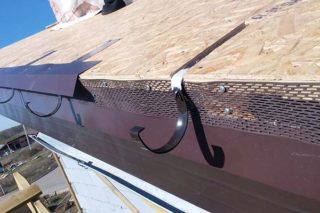
Externally, a roof drip is a metal strip 0.3-0.5 mm thick curved in a certain way, protected from corrosion by a polymer material. The standard length of parts is 1.2, 1.5 or 2 m, which eliminates deformation during installation. The design dimensions of the dropper folds depend on the functional purpose and places of its installation.
Most often, overhang aprons are made of galvanized steel. There are also details:
- made of high-strength stainless steel, which is immune to sudden changes in weather conditions;
- made of thin sheet aluminum, which is bent on a special sheet bending machine.
Drops prepared for use cannot be purchased at the points of sale of building materials. The industry does not produce them. The dimensions of the drippers for the roof are determined individually when developing the roof structure and are adjusted when carrying out roofing work.
The polymer coating of the drip tips can be matte or glossy. The glossy surface shines when exposed to sunlight. To protect it from mechanical damage, its front side is protected with plastic wrap, which is removed before starting work. On the front side of parts with a matte surface, small roughness is applied by mechanical processing to prevent the appearance of gloss.
Appointment
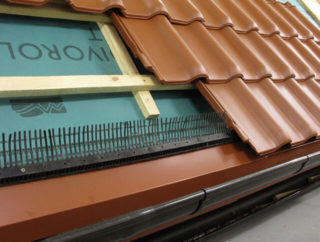
As a rule, the drip is attached under a layer of waterproofing and serves to remove the droplets that accumulate on it. It functions as follows:
- when snow melts or during rain, drops of water flowing down the waterproofing layer fall on the overhang apron;
- the drip tube redirects the water droplets into a drainage chute, which directs them to the funnel of the upright drainage pipe.
With the help of overhang aprons, you can install simple drainage systems and assemble complex, multi-level water drainage systems equipped with drainage channels and storage tanks.
Depending on the season, the drip performs a number of additional tasks:
- In winter, it prevents the penetration of ice under the roof, protects the edge of the latter from the formation of icicles and enhances its resistance to strong gusts of wind. If the drip is not installed, condensation will get under the roof, which can cause rotting of the elements of the rafter system.
- In the warm season, the overhang apron prevents the formation of fungus on the walls under the overhang of the roof and the rotting of wooden parts. In addition, it prevents the masonry mortar from being washed out.
The overhang apron is often mounted over window and door openings.
Classification
Depending on the purpose, roof drippers are:
- cornice;
- pediment.
The eaves drip is used with all types of roofing and is installed on the eaves of the roof. At the same time, there are two bends on the part itself, one of which plays the role of a stiffener, and the second, dividing it into a skirt and an apron itself, directs water droplets into the hanging gutter below.
A gable drip is an indispensable element of a soft roof. It is used if a waterproofing carpet is expected. In this case, the overhang apron is first attached over the carpet and only then it joins the eaves. Its shape resembles the letter T and has three folds - a skirt, a step and an apron.
Roof drip installation
When installing overhang aprons you will need:
- metal blanks, painted in the color of the roof;
- a hammer;
- galvanized nails, roofing;
- scissors for cutting metal.
If self-tapping screws are used instead of nails, the presence of a screwdriver will not be superfluous.
Installation on a corrugated roof
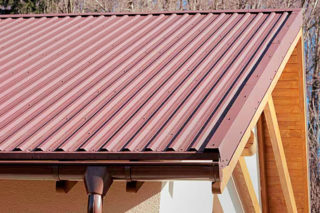
When installing drippers on a corrugated roof, you must take into account:
- Eaves drippers are installed after the roof lathing has been made. They are fastened with self-tapping screws, the distance between which should not be more than 35 cm.
- Pediment drippers are mounted from the bottom up, after the corrugated board has been laid. In this case, each subsequent overhang apron must overlap the previous one.
- When installing droppers, the ventilation gap should not be covered by a panel.
Installation under a seam roof
Seam roofing is a separate, original type of roofing material, the sheets of which (pictures) are connected during installation in a special way - in the so-called rebate (single, double or clickfold). Installation of such a roof requires a special tool and the involvement of workers with some experience in carrying out such work.
The drippers are attached to the last rafter before the waterproofing membrane is laid. In this case, overhang aprons are used, which are used when installing roofs from ordinary metal sheets.
The domestic industry has recently launched the production of special sheets for folded roofs, at the end of which a drip is arranged. The use of such sheets when arranging a seam roof is most advisable.
Mounting on a metal roof
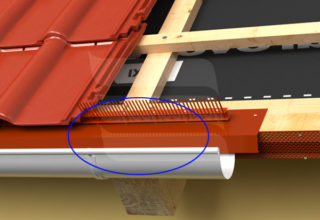
Metal roofing requires the use of both cornice and gable overhang aprons. Moreover, the eaves droppers are attached to the lower rafter even before the roofing is laid, and the pediment ones - after the installation of the latter is completed. Both are overlapped, overlapping each other by 10-20 cm. They are fastened with roofing nails or self-tapping screws, arranged in a checkerboard pattern. At the same time, pediment drippers are installed starting from the pediment overhang, gradually moving towards the roof ridge.
It is advisable to lay a layer of waterproofing between the cornice boards and the drip, which will prevent moisture penetration and ensure air circulation in the under-roof space.
Installation on a soft roof
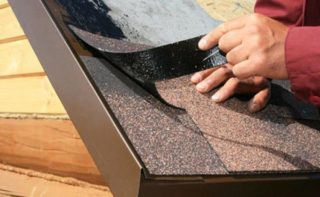
The use of overhang aprons when arranging a roof made of soft materials is important and necessary. In this case, they:
- additionally strengthen the roof structure;
- protect the under-roof space and roof slopes from the effects of strong gusts of wind;
- serve as an additional decorative element of the roof.
An eaves drip for a soft roof is installed before the installation of the roofing material. It is mounted simultaneously with the suspension elements of the drainage gutters. Their location should direct the water directly into the gutter.The installation of the drip under the soft roof is carried out with an overlap and is screwed to the last rafter with self-tapping screws through a rubber gasket. The latter prevents moisture from entering under the mount. If you need to cut a part, use metal scissors. The roof is laid only after their installation is completed.
The frontal overhang apron is installed on the lining materials, but also before laying the soft roof.
Initially, it is necessary to connect the pediment and cornice drippers. They are laid with an overlap and fixed with roofing nails. For better sealing, this connection is treated with mastic glue.
Installation is carried out from the junction of the frontal and eaves droppers up to the ridge of the roof. In this case, the fasteners are placed in increments of no more than 15 cm.








